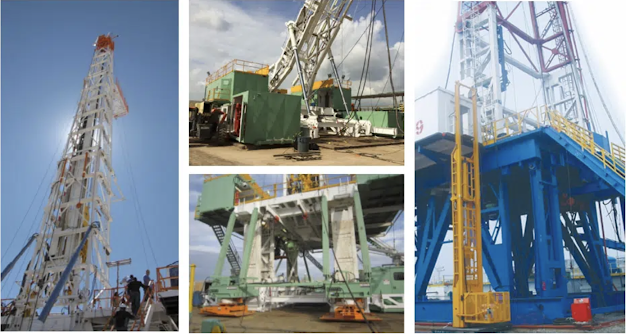Rig & Mast Raiser Hydraulics
Hydraulic Position Sensing for Oil & Gas Recovery Applications
Hydraulic cylinders deployed into drilling platforms such as land-based mast raiser systems are used for oil and gas recovery in a wide variety of fixed and mobile configurations. The hydraulic cylinders used in these systems are going to endure extremely challenging operational environments including temperature extremes, physical abuse, chemical contamination and corrosive airborne elements.
The stakes are high given that these systems are often responsible for raising masts and other equipment weighing hundreds of tons, and failures can be catastrophic to both man and equipment. Requirements for vendors are demanding to say the least. These stringent environmental requirements, plus the long stroke of these hydraulic cylinders and accumulators, and the need for durability conspire to eliminate most position sensor technologies from consideration.
CPI’s SL series of hardened draw-wire sensors is proving to be the technology of choice for linear position sensing in these high power, long-stroke hydraulic systems.
CPI Linear Position Sensors in Mast Raiser Applications.

In this particular mast-raiser system, double-acting telescopic cylinders are used which start out horizontally and move to a vertical orientation during operation. When considering a replacement sensor technology, our client initially considered rod type sensors but quickly eliminated this technology owing to a few important limitations.
- Rod type sensors will have to be very long (> 10 meters) and rod sag and deformation is often a concern in strokes over 1 meter especially in a vibrational environment.
- Rod type sensors are fixed length and problematic for telescoping cylinders.
- Rod type sensors require extremely accurate core drilling of the piston to insert internally and field replacement is almost impossible.
What Makes the CPI SL Series of Linear Position Sensors So Unique?

One of the biggest reasons for this is the fact that the sensor’s assembly and electronics are completely immersion-proof. The draw-wire mechanism is designed to operate completely submerged in any kind of fluid or oil. The fluid literally floods the mechanism and allows our system to be deployed internal or external to the hydraulic cylinder without issue even at extreme depths underwater. Our patented draw wire mechanism is a marvel of material science and mechanical engineering which together yield a mechanism that is all but impervious to pressure effects and the degradation of sea water or hydraulic fluid. In the field, we have sensors deployed that are completely submerged in both. Our sensor has been deployed in the Gulf as a charge monitor for hydraulic accumulators almost 5000 meters below the sea. It can be deployed inside your hydraulic cylinder or externally mounted, fully exposed to seawater.
Our sensor is also ATEX/IECEX rated, making it perfect for deck based hydraulic drilling applications both here and in Europe, on both land and at sea.

Perhaps most extraordinary is the measurement capability of the SL series and the stroke lengths it can handle. While CPI sensors like our SL0390 have lengths of one to three meters, CPI has engineered the basic SL sensor to operate with varying stroke lengths of up to 30 meters (SL6000) and everything in-between.
Two transducer technologies can be specified around our core draw wire mechanism, either LVDT based, or using a very short magnetostrictive sensor (ATEX/IECEX certified). These transducers read the linear position of the hydraulic cylinder through a patented linear to rotary to linear mechanism. The long motion of the draw wire is translated into a small but highly accurate local displacement that can easily be read by our transducer technology. With either technology, the electronic part of the sensors are entirely sealed, and can be configured for deep submersion inside or outside most hydraulic cylinders.
Don’t Forget About Telescoping Cylinders
In gas and oil recovery operations, the use of large hydraulic cylinders is common. One common variation is the telescoping cylinder, used in a wide variety of situations to reduce the overall footprint of the cylinder when retracted or to facilitate rotational or lifting dynamics. Because the cylinder has no fixed length, most other linear position sensing technologies can’t be used. In these deployments, draw wire sensors are one of the few classes of sensors that can handle position detection accurately.
And if your telescoping cylinders are on a drilling platform, a walking rig, or offshore, or deep under the sea, then the only reliable choice in the world for you is CPI.
Contact our engineering team today to discuss your hydraulic position sensing application. https://www.cpi-nj.com/subsea-rated-linear-position-sensors/
This blog was originally published at https://www.cpi-nj.com/rig-mast-raiser-hydraulics/

- Get link
- X
- Other Apps

Comments
Post a Comment